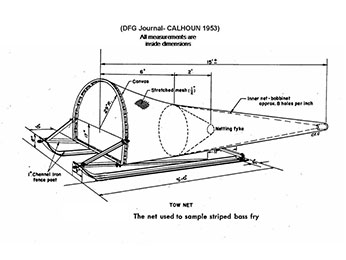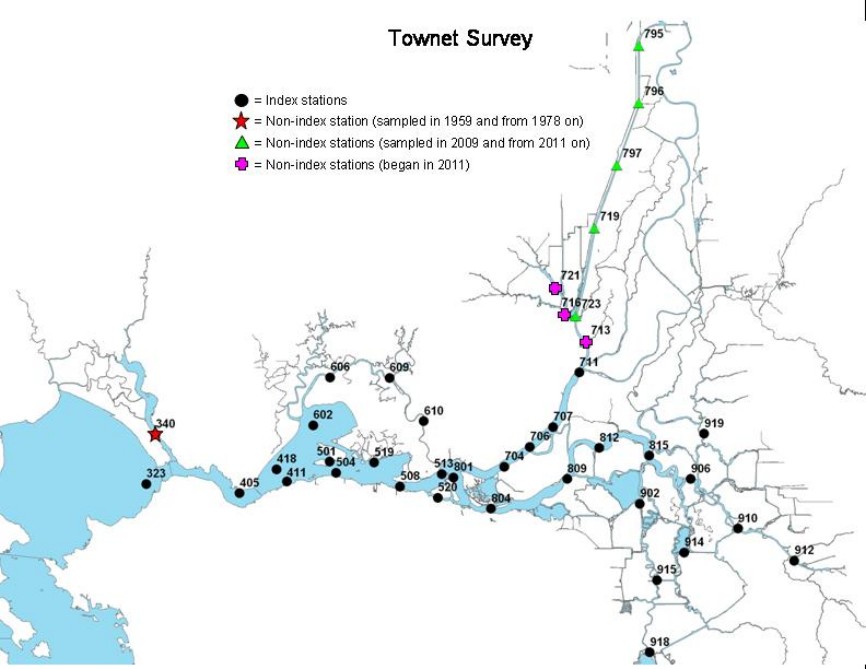Project Overview
 Townet Diagram (click to enlarge)
Townet Diagram (click to enlarge)
The Summer Townet (STN) Survey was initiated in 1959 to determine relative distribution and abundance of young of the year (age-0) striped bass (Morone saxatilis) in the Delta. To predict fishery recruitment, the survey calculates an index to measure age-0 striped bass year class strength. This index is based on abundance when age-0 striped bass attain a mean length of 38.1 mm. In contrast, the delta smelt (Hypomesus transpacificus) index is the average of the first two survey indices. The delta smelt index was developed about 1990 in response to declining delta smelt abundance. It has proven valuable in gauging the health of the estuary; delta smelt abundance trend data was used as supporting evidence for their listing as threatened in 1992 under the Federal and State Endangered Species Acts.
STN samples 32 historic stations, of which 31 contribute to the indices, ranging from eastern San Pablo Bay to Rio Vista on the Sacramento River and to Stockton on the San Joaquin River. In 2011, to better describe delta smelt distribution, as well as that of other fishes, STN added 8 supplemental, non-index, stations in Cache Slough (3 stations) and the Sacramento Deep Water Ship Channel (5 stations). Please see the sampling sites link at right for a map. Historically, the STN began sampling in mid to late June when larva sampling near Antioch indicated young of the year striped bass had achieved a mean size of 25 mm. Annually, 2-5 surveys were conducted, depending on how quickly striped bass achieved a mean length of 38.1 mm. Beginning in 2003, CDFG standardized sampling to 6 surveys annually, starting in early June and running on alternate weeks through August.
The townet has two sections; the first is made of 1/2" stretch, knotted, nylon, mesh 6' long, tapering down to an additional 2' "fyke". This "fyke" fits entirely within the second section, a 9' section of woven mesh with approximately 8 holes per inch. Please see the link at right for a diagram of the townet. The entire net measures approximately 15' in total, and is lashed directly to a fixed metal "D" frame. The "D" frame is in turn mounted on a 22 pound sled. Since 2005, a modified Clarke-Bumpus net and housing have been attached to the top of the "D" frame to sample mesozooplankton prey availability during one of the fish tows at each station. Two 10 minute stepped oblique tows are performed at each station. At historic stations, a third tow is conducted if any fish are captured during the first two tows. STN enumerates all fishes and several invertebrate species. Fork length is measured to the nearest millimeter for all striped bass, all delta smelt, and the first 50 fish per tow for all other species.
STN is mandated by the Delta Smelt Biological Opinion. Historically, STN began in response to the development of Central Valley Project pumping plants exporting water from the south Delta. These exports created a need for information regarding distribution of young striped bass relative to the south Delta diversions. Alongside the collection of other data, STN continues to monitor striped bass and delta smelt distribution in relation to water diversions, for the coordinated operation of the Central Valley Project and the State Water Project.
Station Map / Sampling Sites
